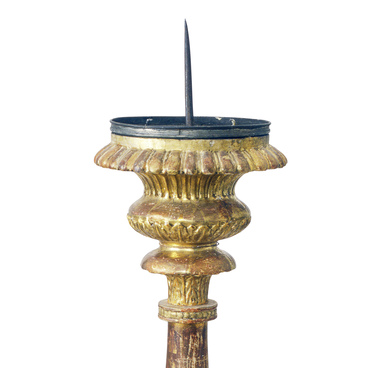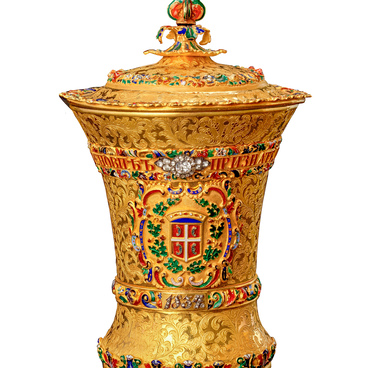Parsuna is the earliest genre of Russian portrait. Such paintings were mostly secular and most often depicted monarchs, boyars and members of the royal family. However, when painting in this genre, artists continued to adhere to the Russian iconographic canons: the faces were often elongated, with fine features, while the volume was not conveyed.
The parsuna of Patriarch Nikon was created by craftsmen of the Moscow Armory Chamber presumably in the early 1680s. The technique, in which it was made, combined oil painting on wood and expensive appliquéd fabrics — silk, velvet, satin. This technique became known in Russia in the 17th century due to the expansion of cultural ties with Poland.
Patriarch Nikon, born Nikita Minov, came from a peasant family and became a monk at the age of 30. He spent about a year in the Holy Trinity Anzersky Skete of the Solovetsky Monastery and then went to Moscow. There Nikon made such an impression on the 17-year-old Tsar Aleksey Mikhaylovich that he left him in the capital and appointed him archimandrite of the Novospassky Monastery. On August 4, 1652, Nikon was elected Patriarch of Moscow and All Russia. At the same time, he made the tsar promise that the secular authorities would not interfere in the affairs of the church. The monarch and the people swore to “obey him in everything, as one obeys the ruler, the shepherd and the father.”
Nikon’s name is closely associated with the reforms of the Russian Orthodox Church he imposed during his patriarchate. For instance, the two-finger sign of the cross was replaced by the one with three fingers. And since that time, Moscow liturgical books have been edited to align with Greek service books.
After the reform, believers split into two camps — the supporters of Patriarch Nikon’s innovations and the adherents of the traditional rites, who were later called Old Believers. Archpriest Avvakum became the main ideologue of the Old Believers.
The rapid rise of Nikon’s career ended with a fall: due to boyar intrigues, the relations between him and the tsar gradually cooled, and the clergy were dissatisfied with the new patriarch. In 1666, when the Great Moscow Synod was convened, he was defrocked and exiled first to Ferapontov and later to the Kirillo-Belozersky Monastery. Only in 1681, the new Russian Tsar Fyodor Alekseyevich allowed Nikon to return to Moscow, but the patriarch died on his way there. At the tsar’s insistence Nikon was buried as patriarch in the New Jerusalem Monastery.
The parsuna of Patriarch Nikon was created by craftsmen of the Moscow Armory Chamber presumably in the early 1680s. The technique, in which it was made, combined oil painting on wood and expensive appliquéd fabrics — silk, velvet, satin. This technique became known in Russia in the 17th century due to the expansion of cultural ties with Poland.
In the second half of the 1680s, the parsuna of Patriarch Nikon belonged to Prince Vasily Golitsyn. Later, when the owner of the painting fell out of favor and was exiled with his family, the parsuna was transferred to the Moscow Vysokopetrovsky Monastery — the burial place of the Naryshkins. The mother of Peter I, Tsarina Natalya Kirillovna, came from this old boyar family.
Patriarch Nikon, born Nikita Minov, came from a peasant family and became a monk at the age of 30. He spent about a year in the Holy Trinity Anzersky Skete of the Solovetsky Monastery and then went to Moscow. There Nikon made such an impression on the 17-year-old Tsar Aleksey Mikhaylovich that he left him in the capital and appointed him archimandrite of the Novospassky Monastery. On August 4, 1652, Nikon was elected Patriarch of Moscow and All Russia. At the same time, he made the tsar promise that the secular authorities would not interfere in the affairs of the church. The monarch and the people swore to “obey him in everything, as one obeys the ruler, the shepherd and the father.”
Nikon’s name is closely associated with the reforms of the Russian Orthodox Church he imposed during his patriarchate. For instance, the two-finger sign of the cross was replaced by the one with three fingers. And since that time, Moscow liturgical books have been edited to align with Greek service books.
After the reform, believers split into two camps — the supporters of Patriarch Nikon’s innovations and the adherents of the traditional rites, who were later called Old Believers. Archpriest Avvakum became the main ideologue of the Old Believers.
The rapid rise of Nikon’s career ended with a fall: due to boyar intrigues, the relations between him and the tsar gradually cooled, and the clergy were dissatisfied with the new patriarch. In 1666, when the Great Moscow Synod was convened, he was defrocked and exiled first to Ferapontov and later to the Kirillo-Belozersky Monastery. Only in 1681, the new Russian Tsar Fyodor Alekseyevich allowed Nikon to return to Moscow, but the patriarch died on his way there. At the tsar’s insistence Nikon was buried as patriarch in the New Jerusalem Monastery.



